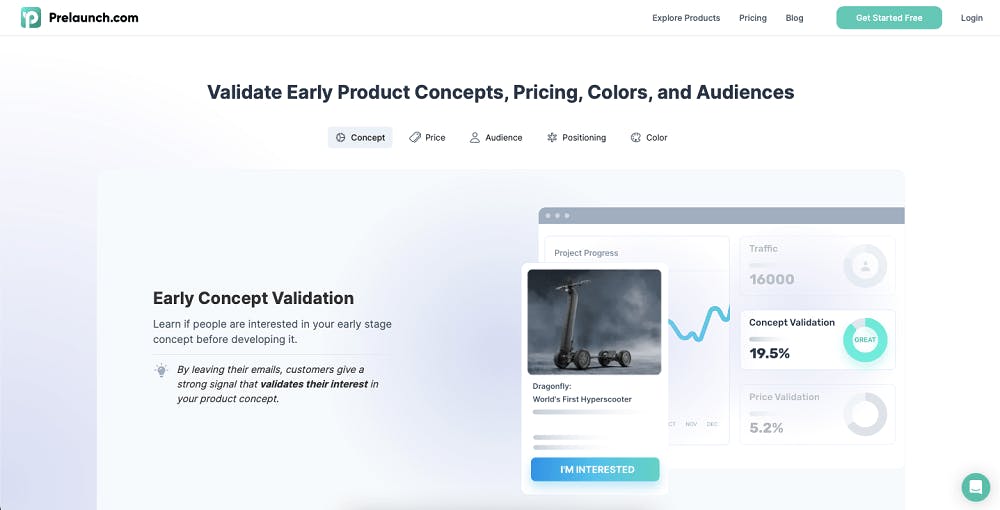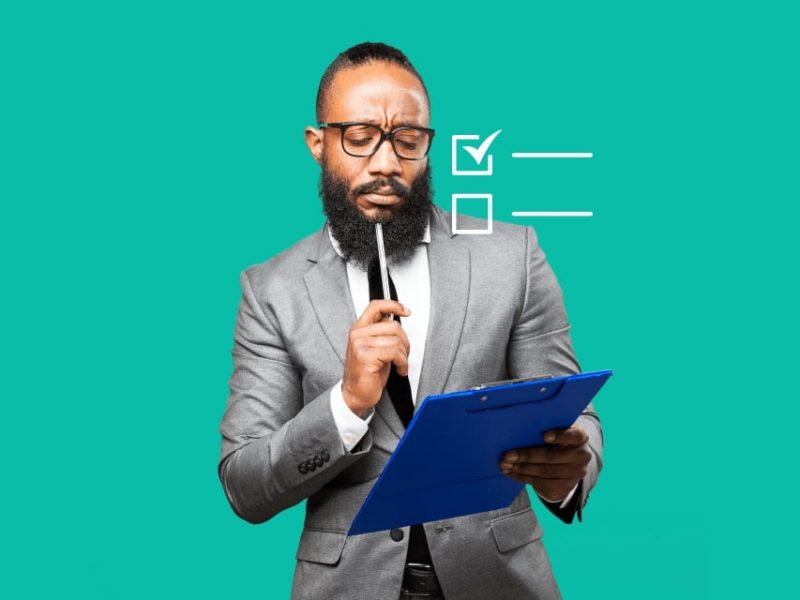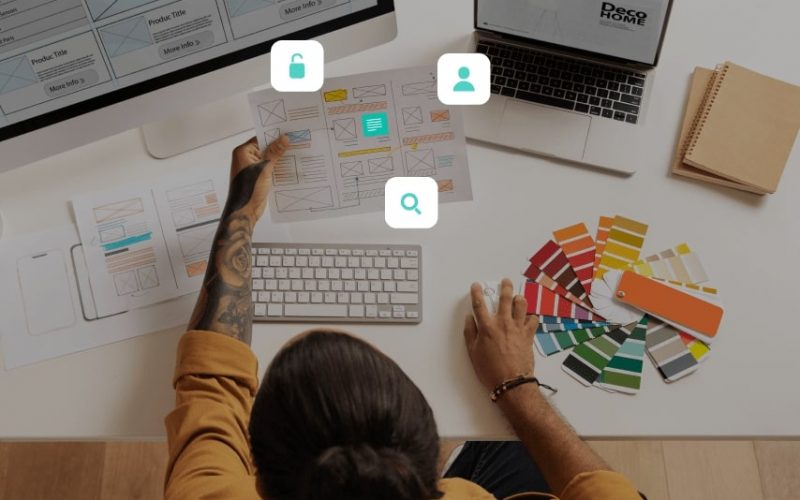Launching new products has never been an easy task. It takes proper planning and execution, along with a great product (of course). The process is different for software and hardware products, so this makes the job of entrepreneurs even more complex.
Introducing – the ultimate product launch checklist – both for software and hardware products.
In this guide, we’ll dive deep into the essential steps of launching a product, along with some nice-to-have steps.
Spoiler alert: The Harvard Business School found that 95% of entrepreneurs fail. This is because they miss the most important step – validation!
Grab your cup of coffee and let’s talk about the strategic product launch checklist you absolutely need to succeed.
Product Launch: Software vs. Hardware
The product launch checklist you’re going to need depends on the type of product you’re launching. In general, software product launches are easier than hardware product launches.
Software products are heavily reliant on digital platforms, which gives an amazing advantage in this digital age. Let’s dig a little deeper and discuss how each launch goes, as well as why hardware products are harder to launch.
How Software Launch Today
Overall, software launches enjoy the privileges of global reach and accessibility, low entry barriers, and cost-effective distribution. From app stores to online promotions, a software product launch checklist is more dynamic.
Once you validate your product and do a competitive analysis, you’ll need to create an MVP and that’ll be enough to launch. However,
Challenges Launching Hardware Products
Launching a hardware product comes with manufacturing issues, inventory management, limited physical reach, etc. Unlike a software product, launching a hardware product cannot be done with a half-made product. So, it requires an initial investment that’s significantly larger.
With a hardware product launch checklist, you will meet a complex set of challenges, the most important one being the absence of a final product.
Let’s dive deeper and see how hardware products handle their launch in today’s digital world.
How Hardware Products Launch Nowadays
The key ingredient hardware product launches need nowadays is – you guessed it – the physical product! But how can you know whether or not you’ll achieve launching success before you invest a ton of funds into development?
The usual product launch checklist for hardware products looks a bit like this:
- Market research
- Prototyping and development
- Supply chain management
- Testing the product for quality assurance
- Marketing processes before launch
- Setting up retail and e-commerce partnerships
- Launch
- Post-launch maintenance
All of this is pretty straightforward if you are willing to take a risk on your hardware product’s success. Let us show you how you can launch safer and more confidently with Prelaunch.com.
Overcoming challenges and minimizing risks with Prelaunch.com
With Prelaunch, you can launch a hardware product just like you would launch a software one. You won’t need a final product, and you’ll be able to gauge your demand in the market and validate your idea, price, and audience by launching before you actually launch.
Thanks to this platform, you’ll be able to use our product launch checklist and launch with confidence and exiting pre-orders. But how does it work?

Prelaunch allows you to build a landing page for your product, test various metrics of success, and build a community around your product before you go live. So, you’ll definitely know whether or not your product will succeed because you will have sold your product already!
Now that we’ve told you a bit about the ultimate product validation platform, let us take you through our product go-to-market checklist.
Product Launch Checklist
We’ve reached the most important part of our new product launch checklist guide. We’ll give you the 16 steps you need to go through to finally know how to launch a product, be it hardware or software.
This product launch plan template is made to be general and applicable to most products.
Important note: The first step is the fuel you need to power the rest of this checklist. If you skip this step, your success will be a game of luck.

1. Validate your product with Prelaunch.com
The first step in any product launch plan should be to validate your product, market, audience, price, and every other possible thing about your brand. Yes, even colors!
The reason most product launches fail is the absence of product-market fit. Do you have a data-backed reason that your product is needed in the market? Is your product a vitamin or a headache pill?
Without product-market fit, you cannot be confident that your customers actually need your product. After all, you need to find a solution for your customers instead of looking for customers for your solution.
Prelaunch.com is the best friend of entrepreneurs who are looking to find product-market fit. To be honest, the platform does much more than that. It tells you what to sell, whom to sell to, where you should sell it, and how much you should charge. Ultimately, it answers the 5 Ws for your product (who, what, when, where, why).
The 5 things you can validate on Prelaunch are:
- Idea
- Price
- Audience
- Positioning
- Color

Prelaunch.com also allows you to get pre-orders on your product even before you build it! This is a stepping stone for products that are also looking to launch a crowdfunding campaign, helping them build a community before they start their funding stage.
In short, if you’re looking to understand whether or not you’re going to build the next Instagram, fidget spinner, or iPhone, Prelaunch is the place to go.
2. Conduct market research to understand your target audience
Market research is an essential step in your product launch checklist for not only finding your product-market fit but also understanding your industry. If you or one of your Co-Founders are not a subject matter expert, creating a product for that market is a gamble.
If you’re not an expert in your industry, don’t worry – you can become one!
Every company does market research to build the perfect product, and so should you. Take the example of Apple – before the new product release of the iPod, they scoured their market and understood that their audience was looking for a sleek, user-friendly music player to replace the clunky Walkman.
Here’s a mini checklist for your market research endeavors.
- Set your objectives for your research
- Choose your research methods
- Analyze your data and learn from it
3. Set clear goals and objectives for your campaign
Once you understand your market and audience, it’ll be time to start building your product launch strategy.
First things first, you’ll need to define goals that are SMART (Specific, Measurable, Achievable, Relevant, and Time-bound). For example, instead of wanting to be successful, set a KPI of 1,000 pre-orders for your first month of launch.
Second, start utilizing online tools for tracking your data effectively. For example, introduce Trello to your whole team and use it to track every process and task. Divide your tasks into mini-tasks and define the frequency of your progress tracking.
4. Develop a working prototype of your product
While you don’t need to have your final product ready yet, you still need a prototype that works. So, here are 3 steps you’ll need to take to have something to show potential users or customers.
- Start with sketches
Gather your design team and get the ball rolling on initial product design sketches. Use tools like AdobeXD or Sketch to get the digital design of your product down.
- Transform sketches into digital prototypes
Once you have the initial design down, start translating those sketches into an actual prototype using online tools like Figma. The only necessity here is to have your prototype show off the key functionalities of your product similar to a digital MVP.
- Make the real thing
If you’re not ready to start manufacturing, you can use temporary solutions like 3D printing to get physical prototypes. For software products, you can start creating the base of your prototype. The goal here is to have a working prototype.
5. Identify your target audience and create buyer personas
No new product launch strategy is complete without a buyer persona section. After all, if you don’t know your customer, your chances of succeeding will be on the lower side. They are the end user, so your product should be built according to their needs and launched according to their timeline and platforms.
In this part of your product launch marketing checklist, you’ll need to do a lot of research and hypothesis testing. Market research will be your best tool for this process.
Step 1: Identify the demographics
Start with defining the demographic characteristics of your target audience. Understand that you’ll be working with multiple sub-groups, so don’t limit yourself to just 1 category. Here, you’ll tackle their:
- Age
- Gender
- Education
- Income level
- Marital status
- And more.
Step 2: Conduct surveys to narrow in on a niche
Now that you’ve hypothesized who your audience is, it’ll be time to test it. Reach out to your potential customers and interview them. Understand their personalities, motivations, pain points, etc. Remember to ask the right questions.
Step 3: Create your buyer personas
Next, you’ll need to create extra detailed buyer personas. This means creating a character of your ideal customer and writing down everything about them. You can also use online tools like HubSpot’s Make My Persona to make it easier.
6. Develop a social media strategy
Social media marketing has been and will continue to be one of the best tools to get the word around about your new product launch. That’s why no product launch checklist is ever complete without an SMM strategy.
If you don’t know where to start, here’s a mini-marketing launch checklist to get you on the right track:
- Choose the platforms where you want to post.
Be precise and pick the ones where your audience is. If you have a younger audience, go for Instagram and TikTok, but if you have a professional product for corporations and high-level executives, LinkedIn might be the way to go. If you’re launching a visual product, Pinterest can also work very well.
- Create a visual style and come up with a content calendar
From choosing how many posts you want to do per month to understanding what they’ll be about and what they will look like, a content calendar is key for your SMM strategy. If you don’t have a visual style yet, develop one that’s dedicated to your social media presence.
Once you have your visuals and captions ready, start posting or scheduling them. Post at the right times – when your audience is most active. Create buzz around your launch with intriguing posts. Don’t post just for the sake of posting.
- Engage with your audience
Being social on social media platforms is key to your success. This is a domaine where your audience can get to know the personality of your brand, so let it out! Comment on their photos, engage with them through messages, and make your company come off as a real person.
If your audience is appreciative of humor, posting funny content can be the way to their hearts. This way, you’ll build a community around your product. Needless to say, when you’re just starting, growing organically can be tough. Audience engagement can be your savior.
7. Create a landing page to capture email addresses before launch
If you’re hoping to have a successful product launch, you’ll need to add this to your product launch plan checklist. Capturing emails can be tough if you don’t have any lead magnets or a place to gather the emails, so go ahead a build a landing page introducing your product.
As a first-timer, it can be tough to build a landing page on your own. So, try using tools like WordPress, Wix, or Prelaunch.com to quickly build a web page.
On this page, you’ll need to have a couple of important sections:
- Tell the visitor about the content through content and visuals
- Use catchy headlines to hook them in
- Make your landing page entertaining – give them a reason to want to stay
- Clearly show the value of subscribing to your newsletter
You must have CTAs all throughout your landing page to help the user navigate your content effectively.
Through advertising campaigns, you’re going to lead people to your landing page and gather your very first email list. But before that, you need to plan out your email marketing funnels.
8. Plan email marketing campaigns
Before you have an email list, you need to have your marketing campaigns figured out. Once someone signs up, it’s in our product launch best practices to send a welcome email and immediately establish communication with them.
So, how do you go about planning your email marketing campaigns for your product launch checklist? Here’s a small tutorial:
- First things first, choose the email marketing platform you’ll use
We recommend using MailerLite for its automation, drag & drop email builder, embedded forms, and other amazing features. - Define your user’s journey or email marketing funnel for each group
For each of these groups, you’ll need to design visually stunning emails with clear CTAs. The more entertaining your content, the more likely they are to stay engaged. - Set up your automation for each campaign
Don’t forget to define clear behavior triggers. For example, if someone doesn’t open your email, send it again after 3 days. That’s the beauty of automation.
Now, anytime someone subscribes to your newsletter, they’ll start receiving emails from you without you needing to press send every time.
The success of your email marketing campaigns will lie in your content, its storytelling ability, and its aim toward conversions.
9. Run advertising campaigns on Google, Facebook, and Instagram
Some of the most popular advertising platforms today are Google, Facebook, and Instagram. They’ll allow you to reach millions of people in exchange for a couple of hundred dollars. So, here’s where you should start.
- Set up ad accounts on Google Ads and Meta Ads Manager (you can run ads on Instagram through this as well).
- Connect all your accounts across these platforms and ensure that they have a good look (right username, high-quality images, posts, etc.).
- Start creating content for your ads. From great visuals to compelling copy, you’re going to need impressive content to grab the attention of your audience.
- Define your target. This is usually the biggest step in your advertising campaigns. Use your customer personas to define the demographic characteristics of your audience, insert their interest, and even narrow it down to their behaviors.
- Choose your budget and timeline. Advertising is a numbers game – the higher your budget, the better your results. However, you’ll need to keep an eye on your results and modify your budget and timeline according to real-time results.
- Measure your data and learn. Never treat your advertising campaigns like a “set-it-and-forget-it” deal. They require constant maintenance and optimization, so track your results and improve your inputs to achieve a higher performance.
Now that you know how to get your online presence off the ground, it’s time to move on to the next point in our brand launch checklist – influencer marketing!
10. Consider influencer outreach
Influencer marketing has been booming for quite some time now, and it doesn’t seem like it’ll be slowing down anytime soon. So, add influencer outreach to your product launch checklist – you won’t regret it.
Now that you have this task ahead of you, where should you start? Here are a couple of things to consider:
- Choose the right influencers. They have to be relevant to your product and aligned with your industry in one way or another. Pay close attention to their personality and whether or not you’d like their audience to become your customers one day.
- Use influencer marketing tools. You can find influencers in your niche and collaborate with them through tools like ViralMango.
- Figure out your collaboration terms. Lay down the ground rules for influencer collabs. Will you be working on a barter basis or do you have a budget set up for each individual influencer?
- Reach out with a personalized message. Send them a DM on Instagram and let them know why you’d want to collaborate with them. Why is your product relevant to their audience?
- Consider offering affiliate partnerships. To give influencers extra motivation to push your product forward, you can choose to work with them through promo codes and affiliate links.
11. Create marketing assets: content for social media, promotional videos, eye-catching graphics
If you’re looking for a safe launch plan checklist, this needs to be in there. Marketing assets like visuals and content centered around your product are key to your success.
Use tools like Canva to create catchy graphics if you don’t have a designer on your team yet. In this day and age, it’s all possible with great templates and just a bit of creativity. Just make sure to have consistency in your branding across all your assets.
Animations of videos are booming in the digital domain right now. So, go ahead and hire an animator or a videographer who can whip up some promotional videos for your product.
12. Engage with potential backers and supporters
Before launching your crowdfunding campaign, it’s important to get to know your audience and foster your community. After all, people usually won’t back you if they don’t have some bond with your brand or product.
The 2 primary places for engaging with your potential backers are social media and email. So, stay active, respond to messages and comments quickly, and keep the conversation going to build a sense of community.
Trust us, if you post content that your audience likes, they will engage.
Through email marketing, you can answer questions and concerns from your audience. Put their mind at ease with an early bird discount in their inbox, and you’ll be set for success.
13. Implement a media PR campaign
No crowdfunding product launch checklist is complete without a media PR campaign. We’ll be honest – media coverage is one of the best ways to raise your goal and more.
If you’ve never been featured on Forbes, how would you know where to start? Well, the trick here is to work with a crowdfunding marketing agency that will handle your PR for you. All the outreach and communication with journalists is not an easy job.
On the flip side, if you do choose to run it up yourself, here are a couple of pointers:
- Start by building out a media list. This means that you’ll need to identify relevant journalists and bloggers, and then gather their contact info to be able to reach out to them. Not everyone has their email publicly available, so you might have to use tools like Muck Rack to get the job done.
- Craft an engaging press release. Keep it short, write up a captivating headline, and only include key information. No journalist has the time to read a novel, so if you want to increase your chances of being featured, you’ll have to play by the rules and be newsworthy.
- Customize your message to each media outlet. Just like a pitch deck, you need different variations for different purposes. Here, you’ll need to make sure to hit home with what you’re sending to each media outlet. In other words, make it relevant for their source.
14. Create a press kit with high-quality images and relevant information
To bring a great product launch checklist template home, you’ll need a killer press kit. Your press kit should house all possible information about your company.
This means that you should include a blurb, your brand guidelines, logo variations, and product descriptions along with all features, and high-quality images of your product.
Pay attention to the format of your press kit. It should all be accessible in both digital and printable formats. Additionally, it should be available in one place.
So, use tools like Dropbox to create downloadable links for any and all high-resolution photos and PDF documents with your product/company information.
15. Register on Affiliate Platforms
A key step for a successful product launch is to tap into affiliate platforms to extend your product’s reach. These platforms make the process so much easier!
With this strategy, you provide affiliate links to influencers, reviewers, and other interested parties, giving them a commission for every successful promotion they make.
Some examples of affiliate platforms include Amazon Associates, ShareASale, and Commission Junction (CJ Affiliate). Each of these platforms offers unique features and extensive networks to help maximize your product’s promotional reach.
Having such a system means you don’t have to worry about individual outreach and negotiations with affiliates – it’s all streamlined for you. These platforms come with user-friendly dashboards, the ability to review your affiliates, and options to add your product to the platform’s marketplace, among other cool features.
Once you register, you’ll need to fill in details about your product, its launch timeline, and your sales goals, plus outline the commission structure you want to offer your promoters.
Conclusion
Launching a brand new product into the market is like jumping into the deep end without even testing the waters. However, we’re here to tell you that you can test the water and even measure the depth before going in.
With our comprehensive product launch checklist, you will be fully equipped with the necessary tools and info to take your product to market. The door is waiting for you to open it. The key is validation through Prelaunch.com.
Don’t let all your hard work go to waste and validate everything there is with a product validation platform. Find your product-market fit, measure your demand, build a product people want, and get pre-orders. It’s all possible with a bit of expertise and the right tool.
We hope this product launch checklist helps you build the next bit thing. Happy launching!




